
Steven Nyman is driving his U.S. Ski Team-issued Toyota Tundra east on Highway 189 toward Heber, Utah. Outside, a spring storm is gathering over Mt. Timpanogos, with blue-gray clouds rising, expanding and spreading vapor wings, dropping rain showers on the valley below. Inside the cab, he’s frustrated with the song stuck in his head. It’s the theme from “Paw Patrol.” He delivers a line or two and laughs. Such is life with two daughters aged five and two.
“How about some Tom Petty?” he asked rhetorically, already working the oversized LCD screen to drop the digital needle on some classics. Soon, he’s singing along to “Runnin’ Down A Dream.”
We had just spent a few hours at Steven’s personal playground, Sundance Resort (although Robert Redford might take issue with that characterization). He took us on a tour of the grounds he grew up on. His formative years were spent there, playing in the forest with his brothers, ripping down the slopes and rubbing elbows with A-list celebrities whom he didn’t recognize, nor did he comprehend their status.
In a sense, the Nymans were the fictional TV family the Waltons, and Sundance was Walton Mountain.
At 41, Steven is recently retired from ski racing. This is no small feat. Most of his peers — Bode Miller, Ted Ligety, Marco Sullivan — all retired some years ago. Ski racing takes an unimaginable toll on the body. No one escapes this reality. It’s just a matter of who can withstand the turbulent onslaught of speed, gravity and age the longest.
In this way, Steven is a unicorn. He’s 6-foot-4 and raced at around 220 pounds. He was naturally shredded, but when he discovered the weight room, he built himself into a physical phenom. However, the sport’s devil didn’t go easy on him.
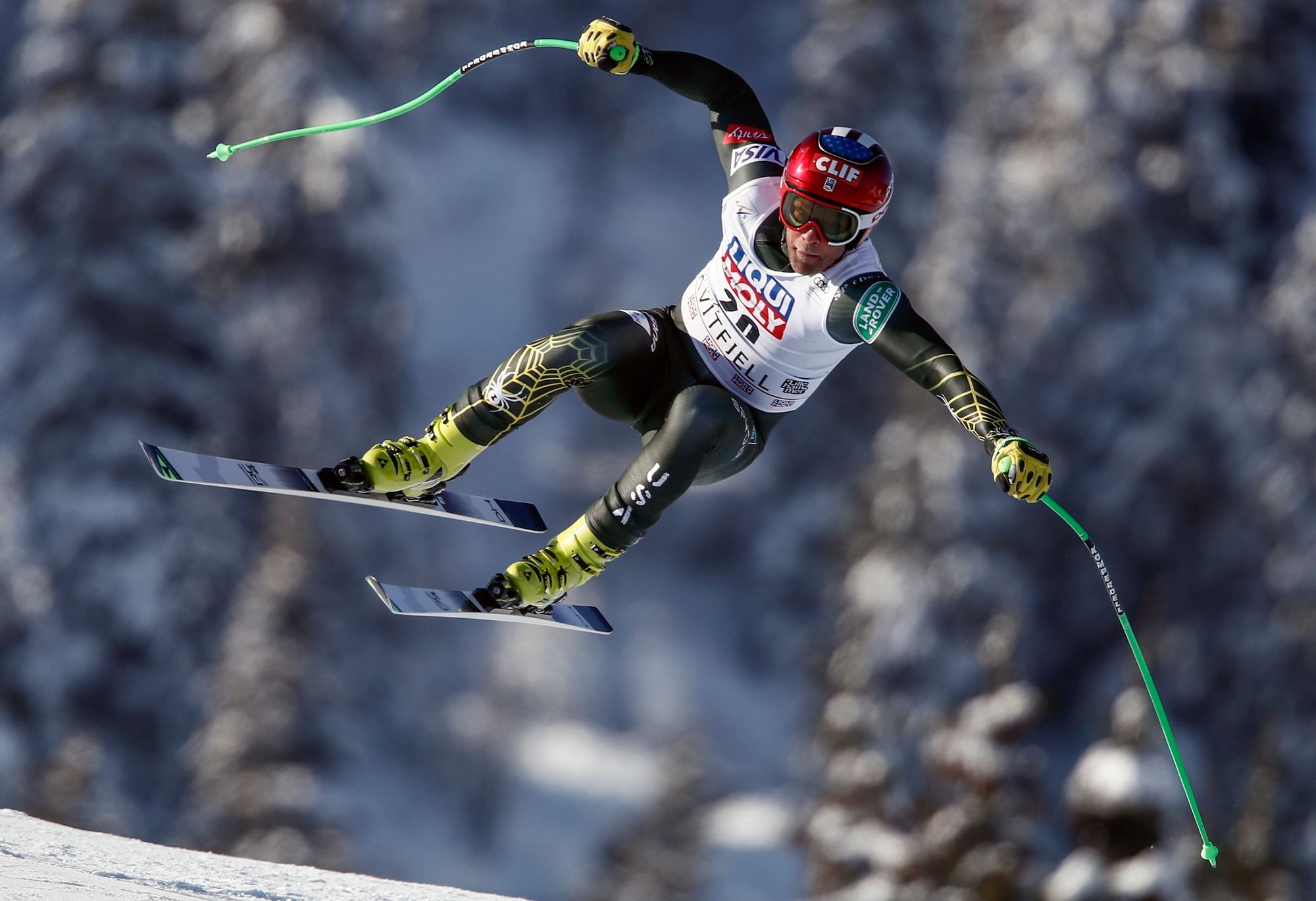
Broken legs (right leg fibula, left leg tibia). Rods inserted. Rods removed. Ripped up knees (right knee ACL, left knee ACL, PCL, lateral compartment). Torn Achilles (left and right). Compressed discs. Bulging discs. Herniated discs. Broken hands. Broken ribs (seven or eight). Neck trouble. Concussions. Insanely violent crashes resulting in helicopter transports to hospitals. And one wreck that was so pummeling, so savage that his body lost control of most functions at the point of impact and, as he says now with a hint of pride, “I shit myself.”
As the gathering storm begins pelting the pavement with raindrops and a low rumble of thunder echoes across the Wasatch, spring has made its arrival known.
It’s a perfect backdrop. Spring is about renewal. Rebirth. Growth. Steven has the bandwidth now — for the first time — to be a full-time dad and partner. To measure and plan his next chapter. To putter around the garage, where his kids have a ninja-warrior-like obstacle course.
For now, he’s no longer running down a dream. He just lived his.
“The mountain would take care of us”
“Moving up on the mountain was a big step for us, and we both grew up in suburbia, but we thought, ‘Why not give it a chance?’ Because my husband worked up here and we thought there was a house for rent, we were just going to stay here for five months over the winter,” Becky Nyman says, recalling the family’s decision nearly 35 years ago to move to Sundance Resort.
“We loved the isolation. We loved the opportunity to be as a family. And we just decided, ‘Let's go for it.’ And so just being up here created this really tight family bond that was really special.”
Becky, a school teacher in Provo, Utah, and Scott, the ski school director at Sundance, had four boys, Michael, Steven, Blake and Sam. Early in their childhood, this move to Sundance Resort — although it was meant to be temporary — was a life-changing decision for Steven.
“We were constantly around the mountain and skiing, and the mountain raised us,” Steven says. “They’d let us boys go and we wouldn't see anybody all day long aside from each other and friends. The mountain would take care of us. And my parents felt safe with that. So the mountain really raised us.”
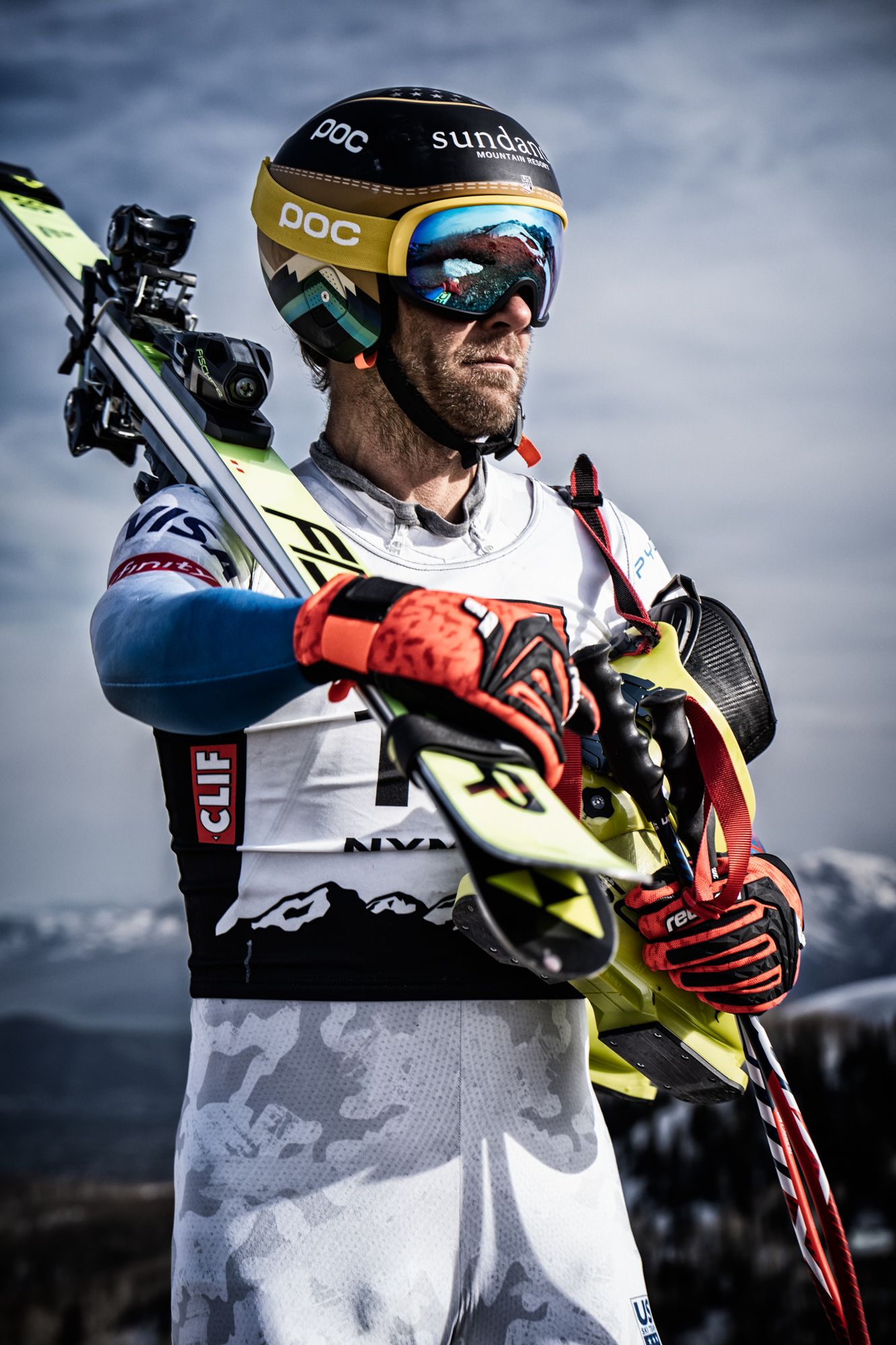
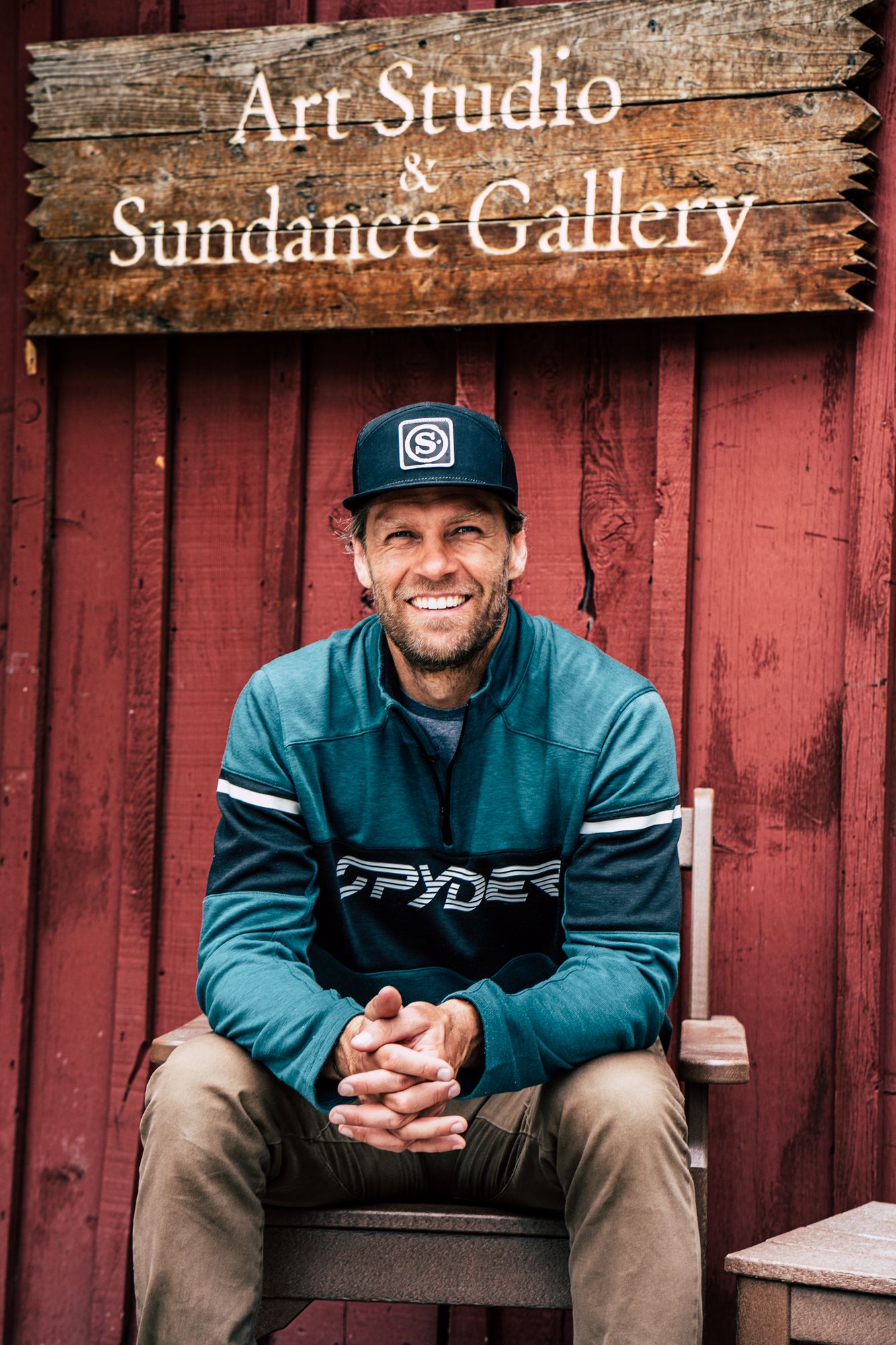
Sundance Resort was – and remains – a major influence in Steven's life. [Matthew Fults photos]
While his father Scott was busy running the ski school, Becky Nyman took on the task of teaching the boys how to ski at a young age. All four Nyman brothers were involved in skiing in some way. But as toddlers, Becky took charge.
“I like to say that my mom taught us how to ski somehow. At one point there were three boys under four years old, and she taught us all how to ski, and showed us how to get on the lift. Somehow she juggled everything,” Steven says.
Sundance is a small mountain compared to nearby Park City Mountain Resort or The Canyons. Because it was Robert Redford’s getaway, the local homeowners and seasonal tourists were often A-list celebrities.
With homes going in the multiple millions, the Nymans took advantage of the seasons and moved from house to house, offering to maintain properties in exchange for free or reduced rent. This allowed the family to continue enjoying the mountain lifestyle in a way they otherwise couldn’t afford.
As such, they didn’t indulge in things like cable TV. The boys bussed to school down in Provo. Friends would lend them Disney VHS tapes, so their exposure to pop culture wasn’t just limited — it didn’t exist.
Sometime in the late ‘90s, Becky was teaching skiing on the weekend to supplement the family’s income and gave lessons to Denzel Washington.
The Nyman boys had no idea who he was.
“You know, the boys really didn't understand,” Becky says. “They were just like, ‘There are people that live here sometimes.’ And so they kind of had this — I don't want to call it a closed view of what's going on — but this really became like their world.
“We didn't have TV, and then when we got TV they would only really watch videos periodically. They didn't really know who Redford was or who all of these people were. And we did associate with quite a few people. But that's what I loved about it, is that we got to expose them to many great, wonderful people, different backgrounds and different faiths and different viewpoints of life.”
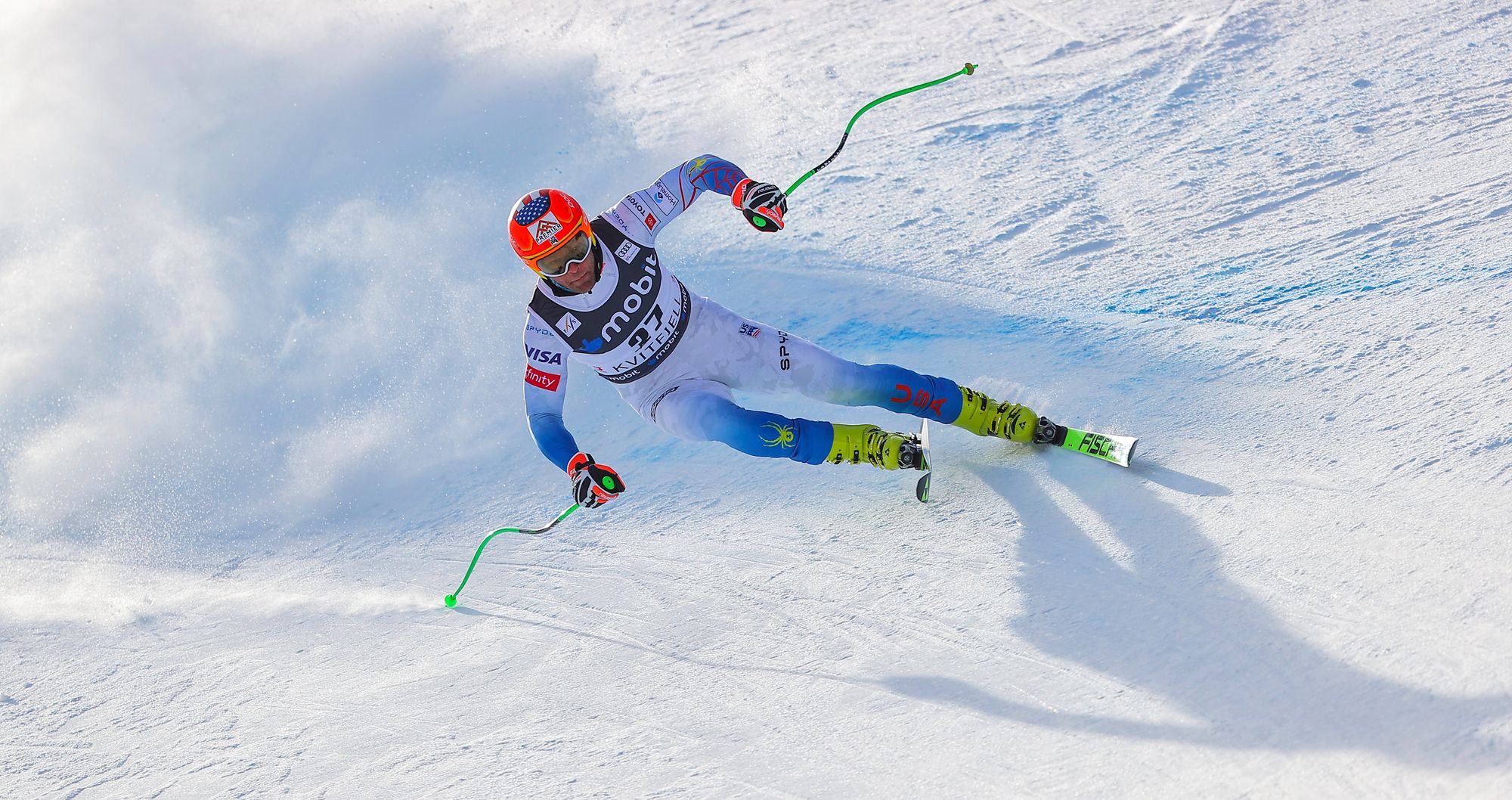
The school the boys attended was year-round, and families were allowed to choose which three months off they wanted. The Nymans picked February, August and October.
“So you got one of the summer months. So basically they skied for the entire month of February. Sometimes I would come down and be teaching (skiing) and they would just have to walk down and ski the mountain, have fun, meet with their friends, have a great time and walk home. At the end of the day, all the lift operators knew them,” Becky says.
This is where the boys’ addiction to skiing was sparked. Steven and Blake didn’t know it at the time, but they were building the foundation for professional careers. And although Michael and Sam would stay involved in the mountain lifestyle, long-term it was Steven and Blake who forged careers carving turns.
For this, they could thank their father. Becky taught them to ski. It was Scott who taught them to race.
“I raised you boys on $35,000 a year”
“Later in life, my dad was helping my brother with his taxes and my brother being a ski bum, my dad didn't expect him to make much money, but he made, I think it was like $55,000. And my dad was like, ‘You made $55,000 this year?’”
“And he's like, ‘I raised you boys on $35,000 a year for four boys.’ On $35,000 a year. That's trim, and with ski racing on top of that, like how I made it, I don't know. How several of us raced at the same time, I do not know. But if it weren't for the support of the community, it wouldn't have happened,” Steven says.
Scott Nyman graduated from college with an accounting degree and later took a job with American Express. At some point, he decided the job wasn’t what he wanted, and that’s how he got involved with ski instruction.
“My grandfather actually played pro baseball back in the day, and he only lasted a year and a half in the majors and threw his shoulder out,” Steven says. “And at that time they couldn't really fix much stuff. So my dad was raised as a baseball player and when he was 17, he told his dad that he hated baseball and didn't want to play baseball anymore.
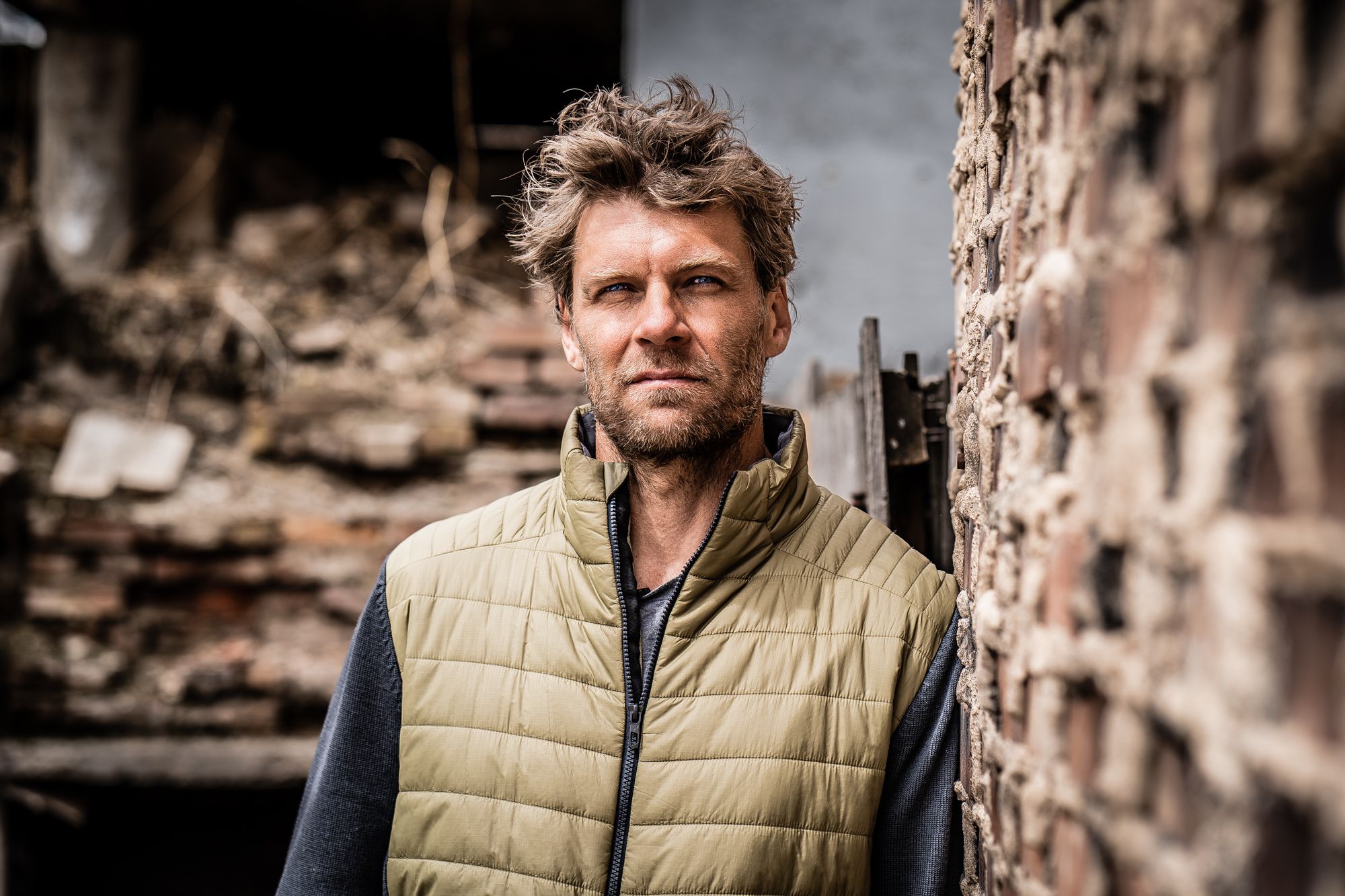
“He was afraid that his dad would be bummed, but his dad was like, ‘If you hate it, why are you doing it?’ And he's like, ‘I want to ski.’ So he took up skiing later in his life. So my dad had this passion for skiing and he pursued that.”
This decision paid huge dividends later in the lives of Steven and Blake.
Blake Nyman was widely considered — even by Steven — to be the best skier in the family. He chose a different route than Steven and wound up doing well commercially by appearing in major ski films and being a professional freestyle skier. So he wasn’t exactly a ski bum, but he was living the life he wanted.
During their formative years at Sundance, it was Scott who was doing the teaching. And Steven remembers a defining moment — one that could have turned the tide completely if not for his goal-driven persona.
“There was a race when I was younger that Michael beat me and he's older — it was expected. But Blake also beat me. I hid under my bed and was livid and cried. And I hated losing. Maybe I'm just more competitive than them, but that was when I swore my brothers wouldn't beat me again,” Steven says.
“And I feel like my brothers were a big motivating factor to me. They were my first challenge, and that's kind of the story of my career: ‘What is the next challenge?’”
Paying for success
In the Nyman family, there’s an old joke that’s tossed around. It’s about Becky and Scott, and who gets credit for what with the boys’ skiing successes.
“The joke in the family is she taught him and I paid for it,” Scott Nyman says with a warm, knowing smile.
The truth is, Steven makes it clear both parents contributed to his success — as well as his brothers. All of those runs at Sundance, day after day, year after year, accumulated a knowledge base for the boys and their father. So when Scott could help, he did.
“I tried to throw pointers at him, but I wasn't too hands-on that much. More just supplementing what some of the coaches were doing. If I saw something was needed, I'd jump in,” Scott says. “I didn't formally coach that much. It was rather informal. Of course, my wife, Becky, she says she taught him and I had very little to do with it.”
With four boys skiing and at least half of them showing signs of competitive fire, I asked Scott if anything stood out with Steven when he was younger. Did you know he was going to be this good?
“He loved it. I mean, he just had this passion for it and just enjoyed skiing fast and just wanted to be on the mountain. And that love, that passion is what fueled him to keep going.”
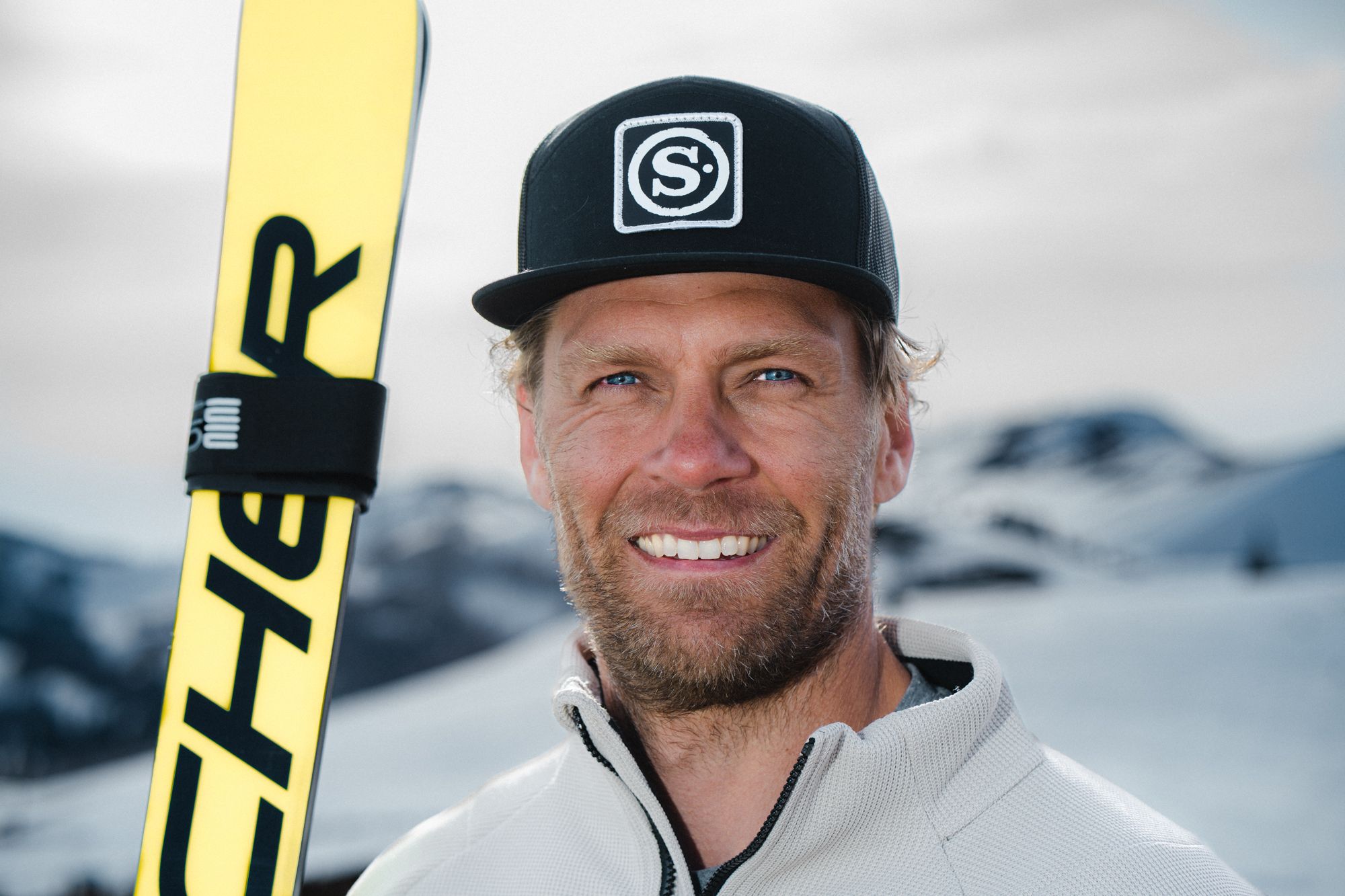
In these early years, there’s a common opponent the Nyman family needed to overcome: resources. The dollar only stretches so far, and the fewer you have, the more elastic they need to become.
As Steven began to exhibit signs of becoming an elite competitor, Scott was left to manage the process. That meant finding equipment, speed suits, and the means of getting him to race after race, regardless of destination.
“We had to scrimp and scrape for this and that, but trying to give him the necessities, he didn't necessarily have all the extra skis and jackets that some kids had. But, you know, those things didn't matter as much as people might think. We had the help of some good friends that would step in and contribute a little bit.
“But we kind of did it on a shoestring budget. Again, it's not so much about money. Money can't buy an Olympian. It's that love of the game I'm coming back to. But because of his desire, we would just find a way,” Scott says.
Sometimes that way was asking friends, family and neighbors to join in supporting his journey. Those people are still at the center of Steven’s memories. Without them, his story certainly would be different.
“I wrote countless letters to community members that donated to my dreams — 10 bucks to a thousand bucks. I just said, ‘Thank you for your support.’ And I treated everybody the same and wrote those every single year. And we had a lot of support and sought-after grants,” Steven says.
This extended to school as well. The Nymans couldn’t afford a ski academy. So they made a pitch to his high school to swap credits and classes for things that would allow him to train in Park City every afternoon. One of those trades was PE for art, and the school agreed to let Steven take art classes at Sundance Resort, where renowned painters and sculptors had studios.
For Steven, there are a few instances at the forefront of his storybook career. Looking back at his youth racing days, he fully recognized the early disadvantages he had — racing in a sweater and “normal pants” among them. But he also saw his parents do everything they could to find solutions.

While racing in the Youth Ski League, which is a regional circuit for younger skiers, Steven noticed he was fast. But he also noticed other kids had things he didn’t.
“At that time, I showed some speed. But we didn't have much money. And I go to these races and I'd be the kid with one pair of skis. Kids would have multiple skis. Other kids would have downhill suits. I just was still in a sweater and normal pants, but I'd make the best of it and push myself to what I could,” Steven says.
“There was a race in Park City where I think I was second and the winner beat me by a 10th. It was Mark Wallace who actually owns Parlor Skis out East. He won. It was this new kid from the east that came in and he won. And he was in a downhill suit, in a racing suit. And I had my sweater and pants and my dad was like, ‘Oh, man, I need to figure out how to get a suit.
“And he surprised us all with these Spyder race suits when we were kids. And they were so cool. And it was probably way too big and probably flappy. And I don't even know how much faster they actually were, but I felt included and I felt special. Once I got that suit, then it was trying to figure out how to get skis.”
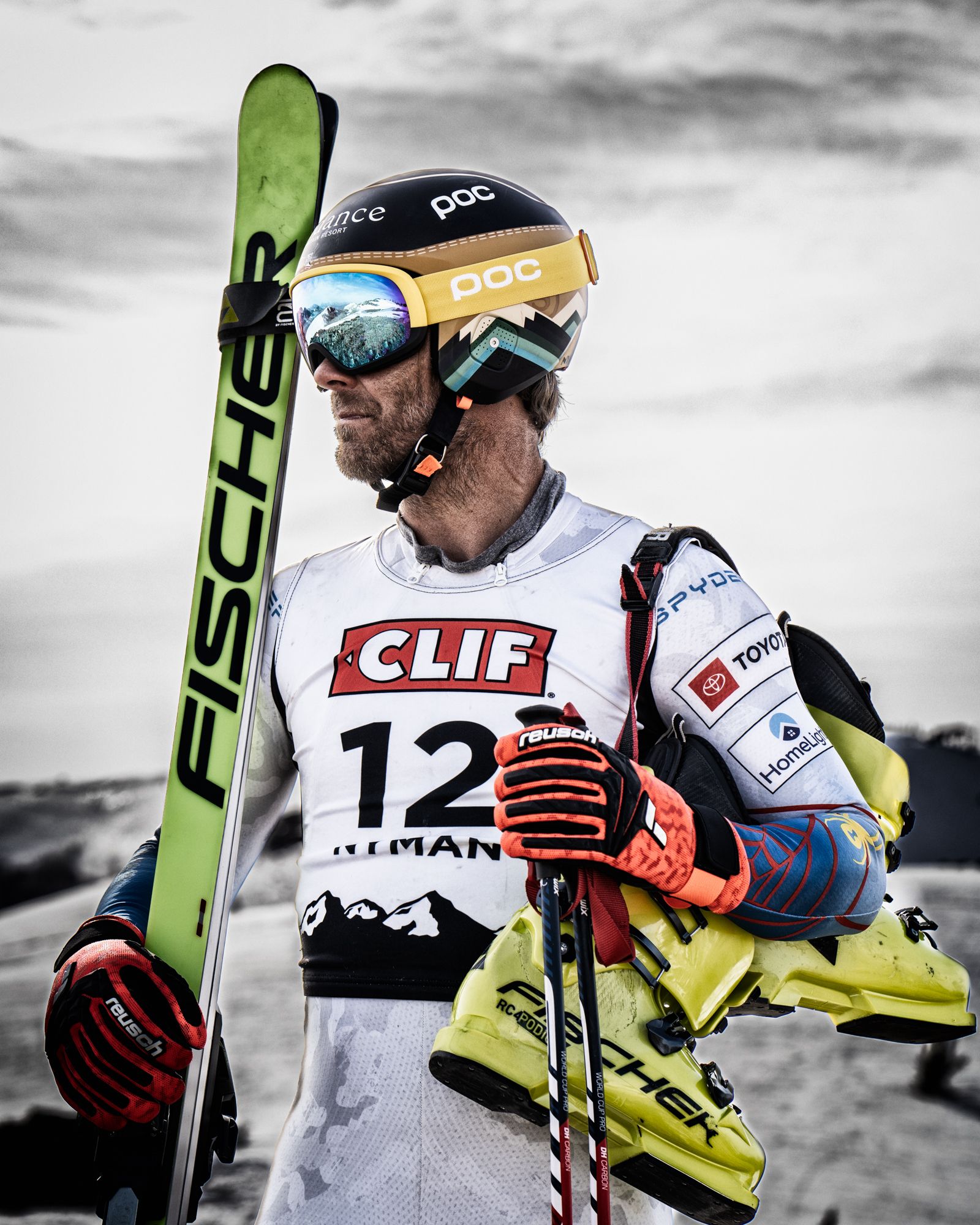
The first taste
With a fresh speed suit on his back, young Steven was now searching for his next kit upgrade: better skis. Scott Nyman, because of his role as ski school director at Sundance Resort, was able to get deals on K2 skis. Think legendary ’70s racer Spider Sabich on his red, white and blue long, skinny K2s.
But this was the late ’90s and downhill skis weren’t really K2’s thing. Different disciplines require different types of skis. Steven, who made his name as a speed racer, unbelievably was racing tech events like slalom. He had just one pair of skis and admits, “Once I started skiing multiple events, I really had to take care of those skis.”
As they often did, the Nymans improvised and found a way to get Steven some longer skis for the speed events by renting from the Sundance shop. Obviously, what you get from the rental shop isn’t World Cup race-ready, but it gave Steven a chance to see what he could do in downhill and super-G.
“Man, I was so slow,” he says with a laugh. “But it was my first taste. I was never dominant, and I was never really leader of the pack when I was young, but random races I’d throw it in there, and I knew I could compete with the best guys in the region.”
Around the age of 14, Steven had a chance to enter his first Junior Olympics competition. But here’s the thing: he didn’t know anything about it. And while just a couple of years later, the Junior Olympics would catapult him onto the world scene, he was still this kid from Sundance who was just trying to make it. He remembers showing up at an event and seeing all these kids wearing the same jacket.
“I asked someone and they said, ‘That’s the Junior Olympic team.’ And I’m like, ‘Who? I beat that guy and I beat that guy. Why? Why am I not invited?’
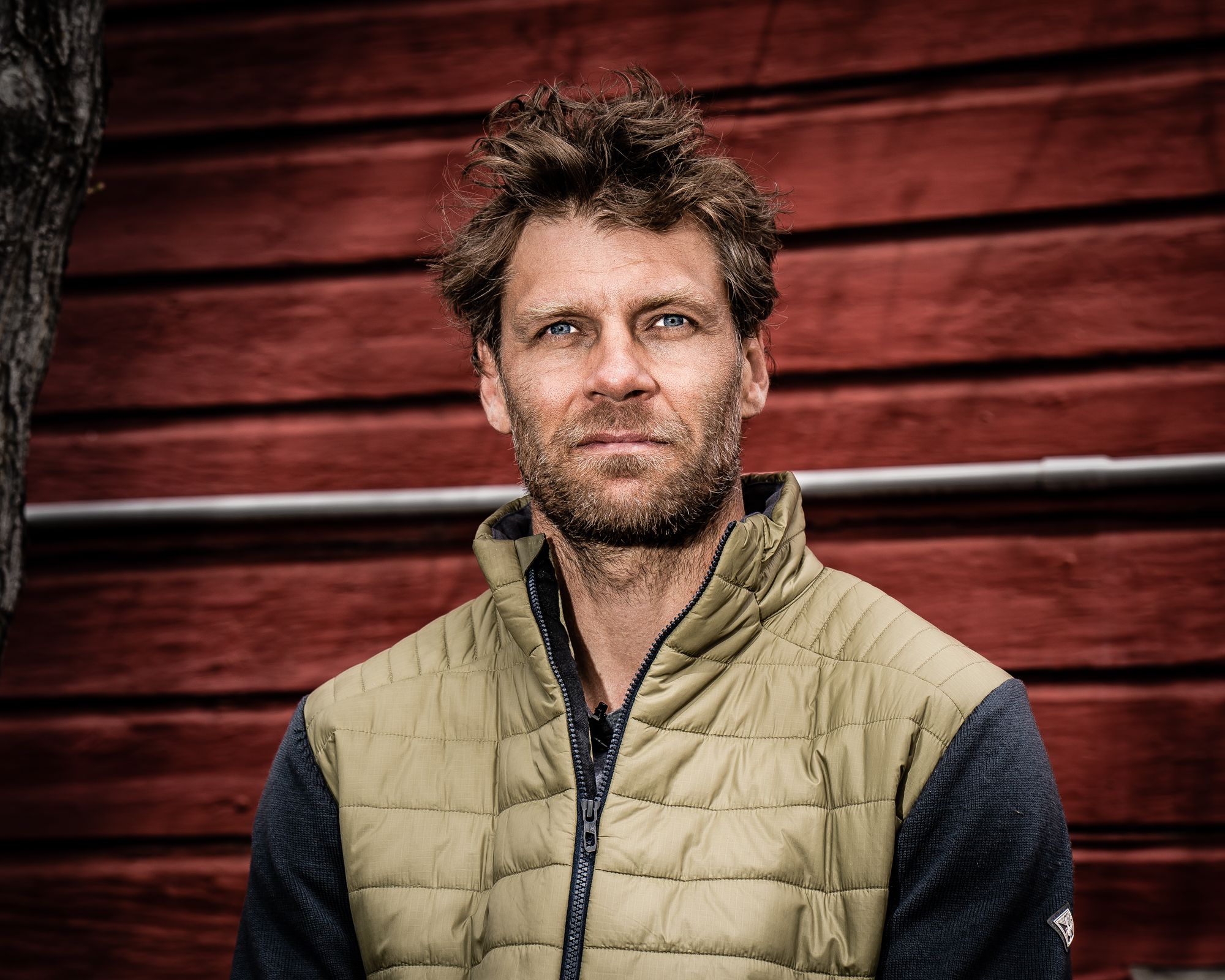
“I hadn't signed the right form because I didn't know. We didn't really know much at Sundance. We just ski. And if the racing wasn't good, we'd go free ski, and we just instilled this passion for skiing within us.”
Time and again, passion — love as Scott Nyman called it — would be Steven’s vessel. If Sundance filled that vessel with passion for the sport, Steven would soon steer it around the world.
The year after learning about the Junior Olympics, he qualified. Two years after that, he was on the podium. Always looking ahead — always chasing just like he was chasing his brothers — Steven was looking for his next stage to conquer. He set his sights on the U.S. National Championships. A familiar refrain ensued.
“I missed Nationals that first year. But then qualified the next year. Then, I saw the Junior Nationals podium, and I wanted to shoot for that and I got that the next year and qualified for World Juniors.
“I saw some of my friends had made that, and every year I’d see something happen to my friends in front of me and they would inspire me to chase after that and reach for that goal. As a kid who bought stretch pants for $10 at the Park City Ski Swap, I made it.”
As it turned out, World Juniors was the early defining moment in his burgeoning ski racing career. With a little help, he finally became a bona fide contender.
“Right before World Juniors, I was in Park City and a former coach of mine, Mike Day, he was in Park City for the 2002 Olympics and he was coaching Bode Miller at the time. We had created a bond when he coached me in Park City Ski Team and he said, ‘Steven, I just want you to try these skis.’
“And he gave me a pair of Bode’s Fischer skis, and I felt like a god just skiing down the hill. I was training next to the Olympians, feeling super fast, super balanced, very good. So I took those skis to World Juniors and ended up winning, beating out Aksel Svindal, who's one of the greatest ski racers of all time.”
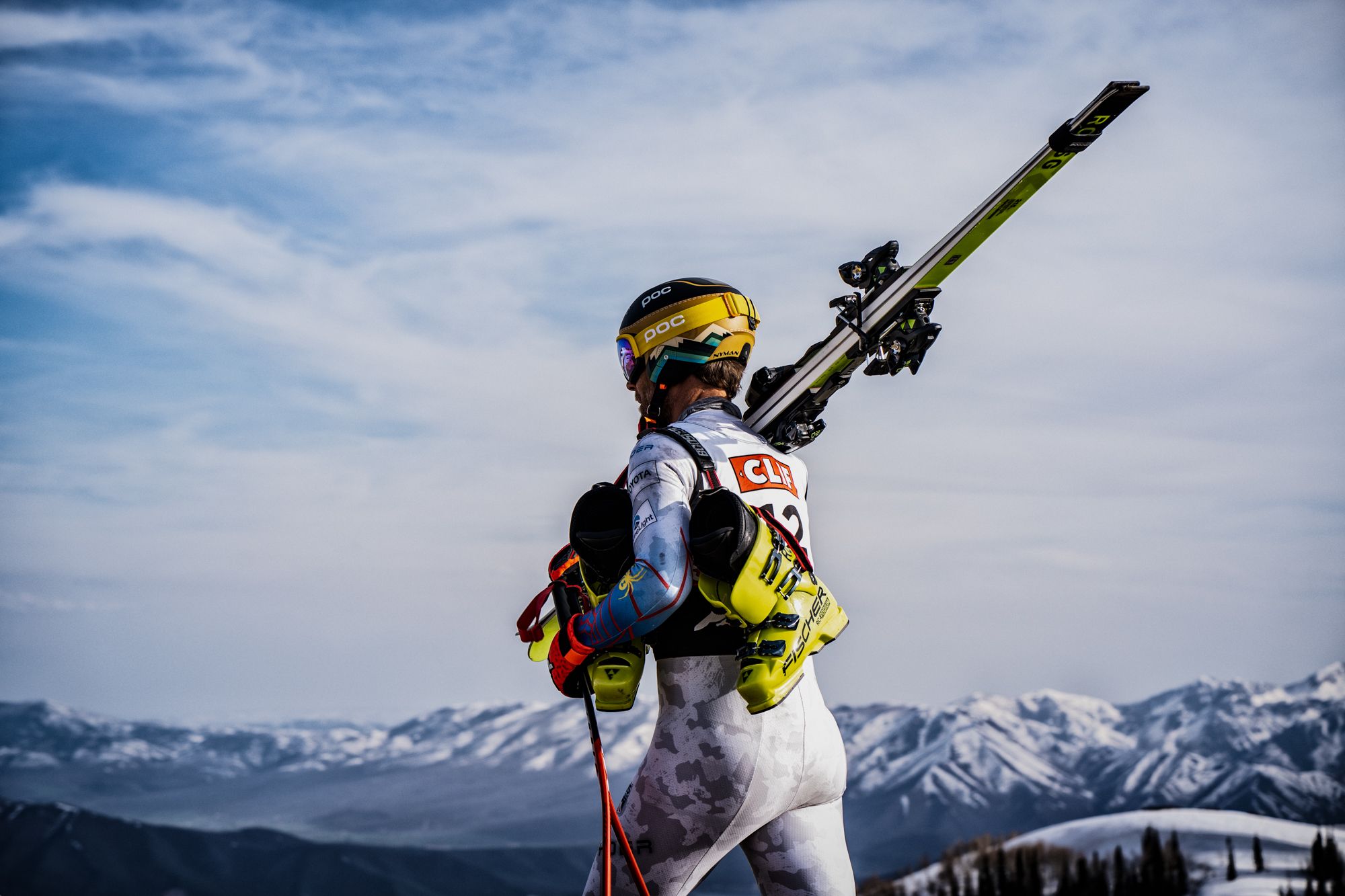
Shoulder shrug. Palms up. Sly smile. Notta big deal. He was a discretionary pick for the team and brought home gold in slalom and silver in the combined event.
For his dad, all of this was unexpected. He decided at the last minute he would join Steven in Tarvisio, Italy.
“We scrimped and scrimped, and I bought a ticket to Italy and went over and the expectations were low. But wow,” Scott says today with the same wonderment he felt in 2002, “that’s when I started to realize this kid’s pretty fast.”
As Steven says, “It's pretty cool to look back on. There's just this total nobody kid never invited to any ski team function, and all of a sudden I'm shot up to my first World Cup. If you win World Juniors, you get to go to World Cup Finals.”
Soon, Steven found himself in Austria, “shaking in my boots” as he finished nearly last in his first slalom run. With his second run and the starting order reversed, he had a fresh track and rocked a sixth-place finish, placing him 15th overall and earning valuable World Cup points.
Those points are currency. They allowed him to move onto the B-team for the U.S. squad, one level from the top.
“I went from a nobody to the U.S. B team, and I was the Next Thing. A few weeks later, I’m in Venice, California, skateboarding and I crashed and broke my leg.
“They were not happy.”
“Wouldn’t it be cool if I were in the Olympics some day?”
In 2002, Salt Lake City welcomed the world for the Olympic Winter Games. The Nymans received two tickets to the Opening Ceremony, and Becky took Steven. There, she remembers her nearly 20-year-old son saying, “Wouldn’t it be cool if I were in the Olympics someday?”
Turns out, the dream was just an Olympic quadrennial away. But first, about that broken leg from skateboarding …
“With that broken leg, I couldn't make quick slalom turns and couldn't do certain things in the summer training,” Steven recalls. “So I kind of leaned toward the speed side. A longer turn was easier on the body, and I realized I was pretty good at that.
“K2 back in the day didn't have great speed skis, so I didn't know my potential there. I showed a lot of promise (in speed), and I did focus on slalom, but I just got crushed that whole next year. And that was kind of the peak of my slalom career was World Juniors. And then I just started shifting towards speed.”
In May 2002, Sasha Rearick joined the coaching ranks around the same time Steven ascended to the U.S. team. In fact, he was on the receiving end of Steven’s email.
“I was a young coach coming out of Green Mountain Valley School and I came to Park City and got this email from Steven, and his email was storminmormon@hotmail.com and I’m like, ‘Who is this guy?’ When he showed up to the gym, he said, ‘Coach, good to meet you. Can’t wait to work out. I’ve never lifted weights. Teach me how to do this and I’ll be here every day,’” Sasha recalled.
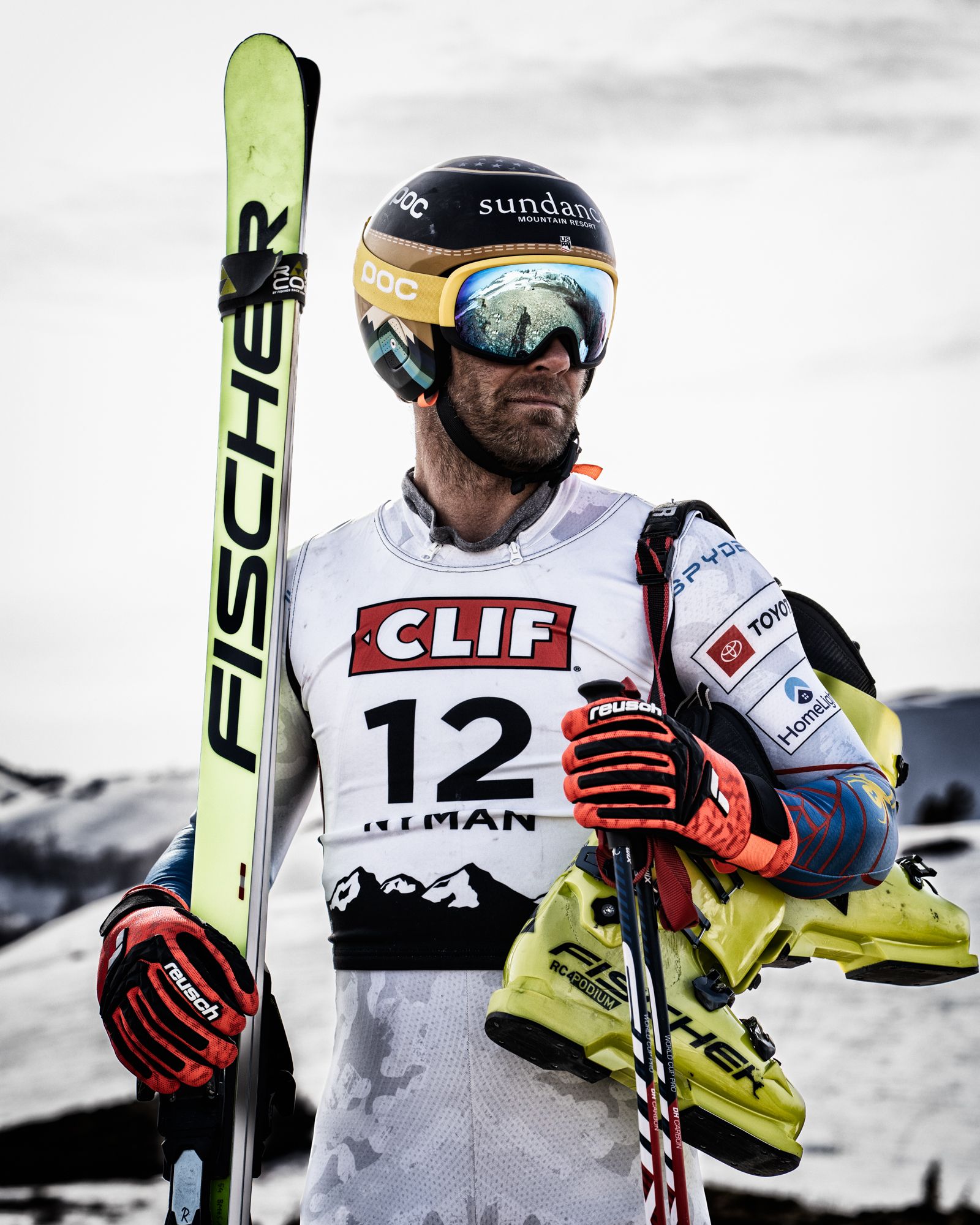
Steven indeed showed up every day.
“He ate us out of house and home in the gym. Every bar … anything that we had for food. He’d come in and eat it and he worked out and he put on 20 pounds.”
Looking back, Sasha says this was a mistake. Steven had put on too much weight, which contributed to sluggish times in his slalom races. It was, Sasha believes, the primary reason he “got crushed” in slalom races the next year.
“But he ended up learning how to scale up to speed because of the strength he had put on,” Sasha says.
With his vessel finely tuned, Steven set off for some Europa Cup races to gain experience. This is one level below the World Cup circuit.
“I was rolling in confidence and I had done pretty well in some previous races. I got to this race series and it was more of a sprint downhill and I knew that I could do really well. I just saw what I needed to do. Felt comfortable,” Steven says.
He ended up winning the race — in fact, no U.S. skier had won a Europa Cup race since Bill Johnson in the early 1980s. The next day, Steven did what Sasha Rearick says “A lot of rookies do. They push it a little bit more.”
He crashed, breaking his tibia and fibula. Doctors inserted a rod to help him heal.

“When you get a rod in mid-season, it's always a complicated thing because the next season, you're still skiing with that rod in your leg. And the docs wanted it to be there because they want to make sure that that bone doesn't break again. But it never feels quite right,” Sasha says.
That’s two broken legs in under two years. He toiled on the NorAm circuit the following season, his leg burning with pain from the rod. The end of the season was approaching, and the top two finishers overall got a place on the World Cup team the following year. With two races left in the season at Mammoth Mountain, California, Steven found his groove again.
“Mammoth turned out to be a sheet of ice top to bottom, and I laid it down and won two races there. We actually broke over 100 miles per hour, and I ended up second in the standings and got placed on the World Cup the next year,” Steven says.
Figuring it out
The next year was 2005–2006. An Olympic year.
As Steven says, “I just had expectations to learn about the World Cup and figure it out.”
But sometimes, innocence is bliss.
In his first race in Lake Louise (Canada), the course was all ice — what speed racers prefer: He finished 17th.
Next was Beaver Creek (USA): 24th.
And as the White Circus headed to Europe, he continued stacking up top 30 finishes and earning valuable points. In fact, the famed and feared track in Kitzbühel, Austria — the one that is so frickin’ scary that grown men have backed out of the starting gate to contemplate retirement — Steven finished 27th.
In a matter of days, he was named to the 2006 Olympic team. He felt the stars were aligning for him. He was skiing well. And then …
“I focused on all the wrong things and did not perform that well. And I learned the lesson that there’s a lot of the world watching. All eyes are on the Olympics at that time, and it was a cool situation to be in, but man, I was not good then.”
Rather than that being the end, it turned out the Torino Olympics were just the beginning. Weeks later, at Garmisch-Partenkirchen, he finished fourth in downhill. Overall, he was top 25 in that discipline, earning a berth to World Cup Finals.
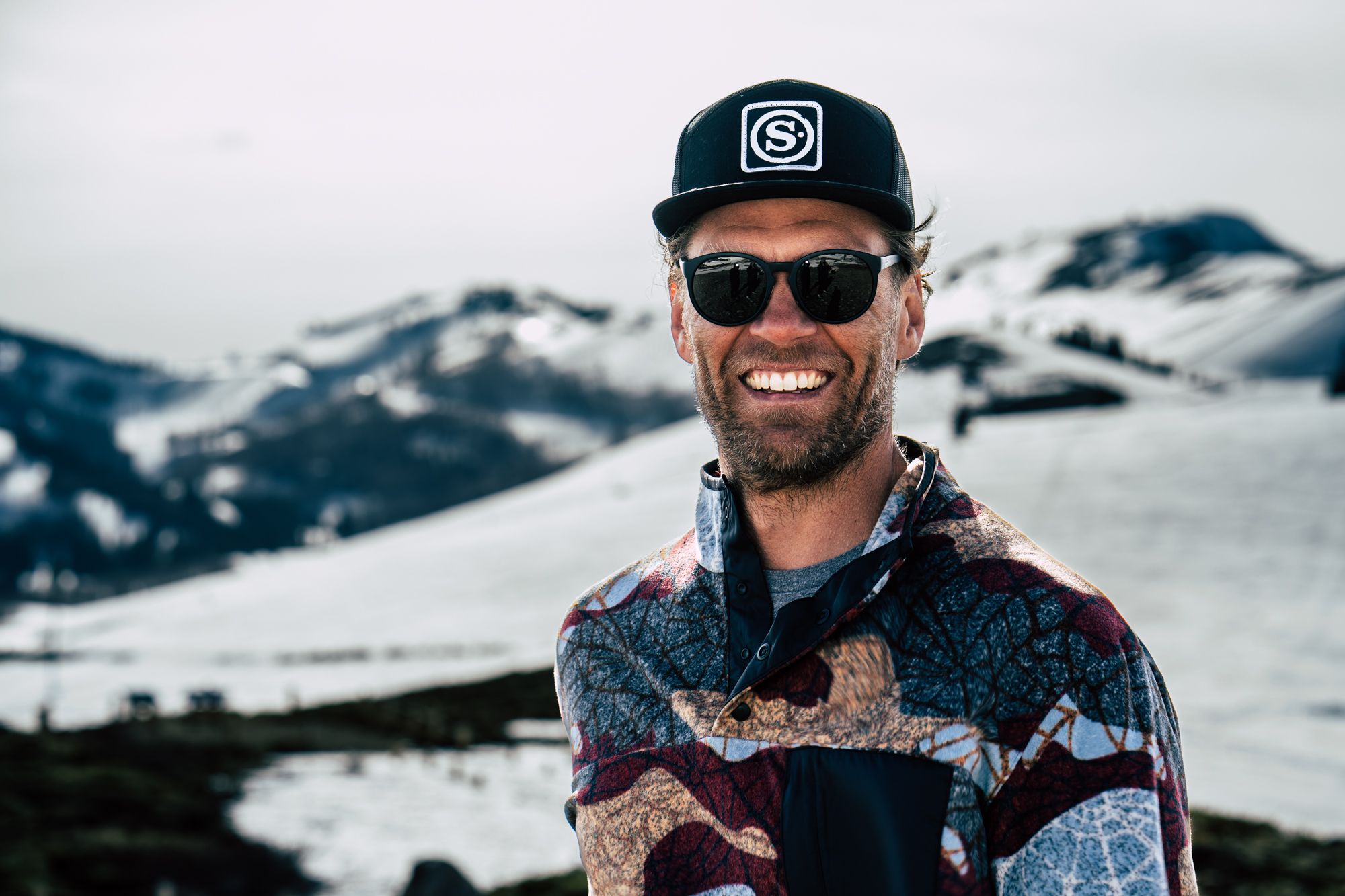
Fischer Skis signed him and assigned a ski tech that summer. Things were starting to click. In November of 2006, he admits to feeling “on fire.” He finished third at Beaver Creek, sharing the podium with first-place finisher and teammate Bode Miller.
Two weeks later, in Val Gardena, Italy, he scored his first World Cup victory, beating legendary Swiss racer Didier Cuche.
“I had this conviction and this feel for the snow and my technician had won there three or four times prior, so I knew my skis would be fast. I laid it down and it was a wild, totally out-of-control run. But I won.”
Soon, though, the sport’s devil would find Steven and injuries to his back would slow his progress for the remainder of the season. But the most important thing was he now knew he could podium. And that changed everything.
A summer of rehab had him feeling great for the 2007–2008 season. Beaver Creek was another success with a second-place finish. Val Gardena, the site of his first World Cup, had him anticipating another victory.
“Went to Val Gardena and wanted to prove myself again. Kicked out of start gate, stepped on my skis, face planted with all the attention of the ski world on me, and that kind of sent me in a tailspin for a while. There was a bunch of different factors, from equipment and my approach and all this stuff that was going on.
“I was the new thing. A lot of stuff was being offered to me. I didn't know how to really juggle it all, and I didn't do that well. And I just kind of hung on until the 2010 Olympics. I qualified, but I had to have a race off with my good teammates, Marco Sullivan and Scott Macartney. I ended up qualifying for the Games and got to race essentially a home Olympics in Vancouver in front of my family and friends.”
As one of the team coaches, Sasha Rearick saw first-hand what Steven was grappling with.
“Leading from Torino to Whistler, the expectations at that age, where you start to think, ‘I'm the man,’ and all of a sudden you go, ‘No, that's not the right way.’ And he started to drift, and he started to go a little bit left a little bit right, different ideas,” Sasha says.
“But those ideas probably weren't going in a clear path. And he definitely got himself lost there for a few years. After 2010, he started to get himself a more clear track, a more clear line. He started working out with some coaches that said, ‘Hey, here's the way to go. Let's go this way.’
“I think that's one of the things that all athletes struggle with, is they start to do well or they have this idea that they expect certain results. And as soon as you start to have expectations of results or where you should be, you're screwed. You're absolutely just done. And the only thing you can expect of yourself is to give 100% effort to get better, to try to do your best to get better the next day.”
Becoming a leader
The next Olympic quad — Sochi 2014 — saw two major things happen for Steven. The first and perhaps the most important: He was becoming a leader on the alpine speed team, and his input was being sought.
“In 2011, I tore my Achilles that fall at Copper Mountain. It was just some dark years. Bode (Miller) was on his own program tour, so he wasn’t around. We didn’t have a lot of leadership on the team, and we had the opportunity to get a new coach and I got to help,” Steven recalled.
Before he knew it, he was on a plane to Europe, where he helped interview some of the top coaches in the sport. But there was one who wanted to work with the U.S. team: Andreas Evers, the Austrian coach who, by most measures, was the winningest coach of all time. Think Hermann Maier, Benjamin Raich and Michael Walchhofer, who combined for 109 World Cup wins.
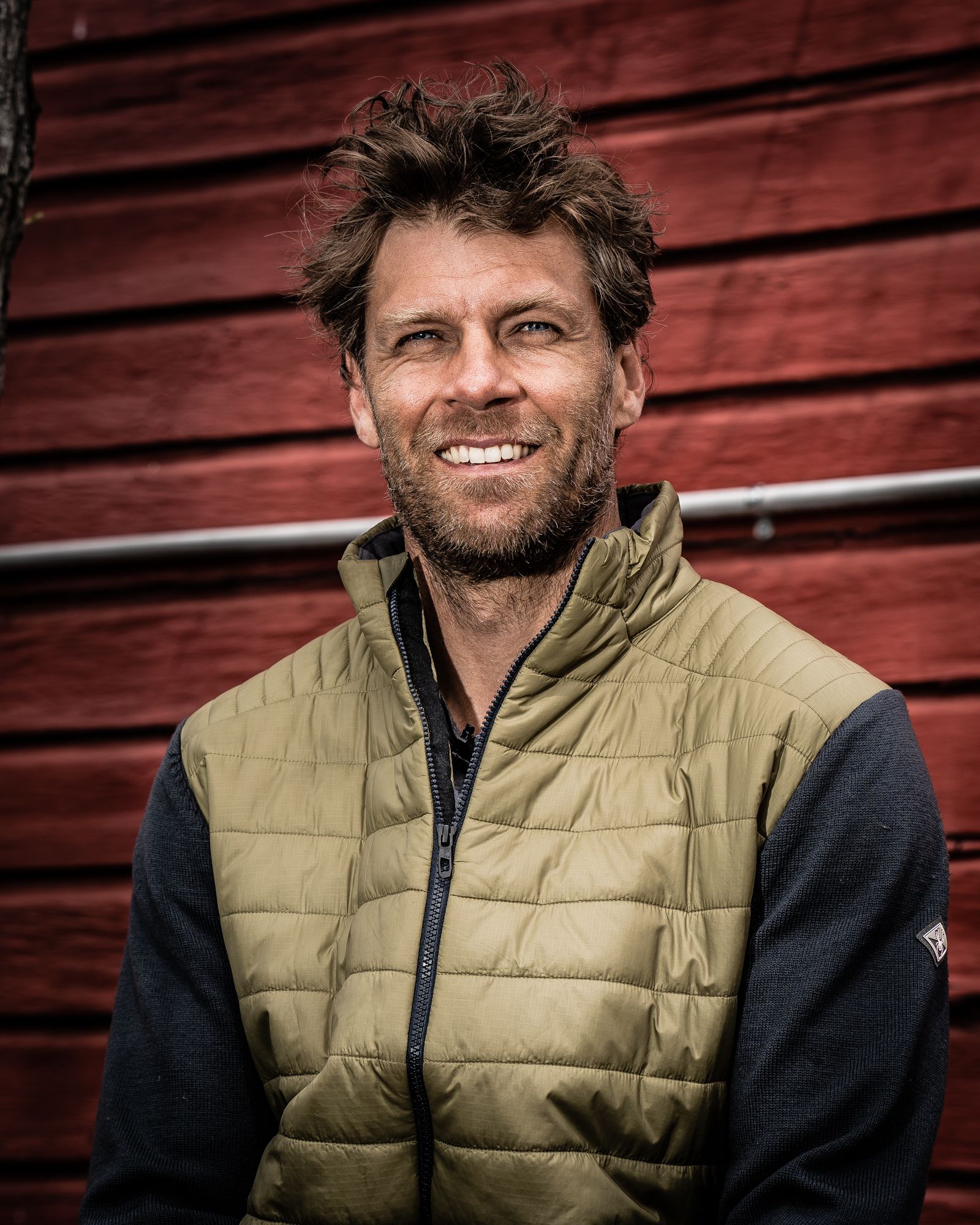
“I said, ‘It’s a no-brainer. Let’s get this guy.’ He didn’t speak very good English, but he taught me so much. He taught me about discipline and focus, different scenarios and training, you know, all these different methods, technique, the simplicity of ski racing in America. We tend to overanalyze all this stuff. And he simplified everything again in that first year, and I won Val Gardena for the second time.”
Once again, though, the sport’s devil found Steven. While he made it count in Val Gardena, he “crashed every race but one the rest of the season.” Steven, however, believes the win at Val Gardena saved his career. That win trumped all the crashes — it gave him currency he could spend when needed.
In the Olympic year, 2013–2014, he was still struggling.
“I kind of made my way to the Games and I had to race off with my good friend Erik Fisher, and I beat him out, ended up racing in the Olympics. It was an incredible experience.” He finished 27th in downhill, indicative of the struggles he was having that season.
He and his mom Becky went to Istanbul following the Games, and Steven spent some time roaming around in the spice markets, alone with his thoughts. He wasn’t content. He wanted to fix what he could.
“I started tearing apart what had gone wrong throughout the year. ‘Why am I fast to certain sections? Why am I slow in other sections?’ And we revamped basically our skis, and I approached Fischer and was just like, ‘We need to fix these things. I'm so fast here but so slow here. Let's just blow it all up and make something that we think is going to work.’
“And we did that, and everybody had kind of bailed on the Fischer speed program, but I stuck with it. And then that summer, they fixed my boots and it was on. It was really cool to feel what I felt, what I used to feel when I was younger.
“And I knew I could win. I knew I had won before. I knew I'd been on the podium. I'd been taught these methods from Andy Evers, and now I could apply everything. I felt like I had the whole package and went to Lake Louise, won training runs, messed it up again. That place has my number. Went to Beaver Creek, was third.
“I had a great year. The next year I started off slow, but halfway through the year, I figured it out. I ended that year with four podiums in a row: Jeongseon, Chamonix, Kvitfjell and St. Moritz (all in 2016). That gave me a lot of confidence and drive for the upcoming championship run. Any Olympics or World Championships I was always injured or always on a comeback and never in prime shape. I was very motivated in 2017 for St. Moritz.”
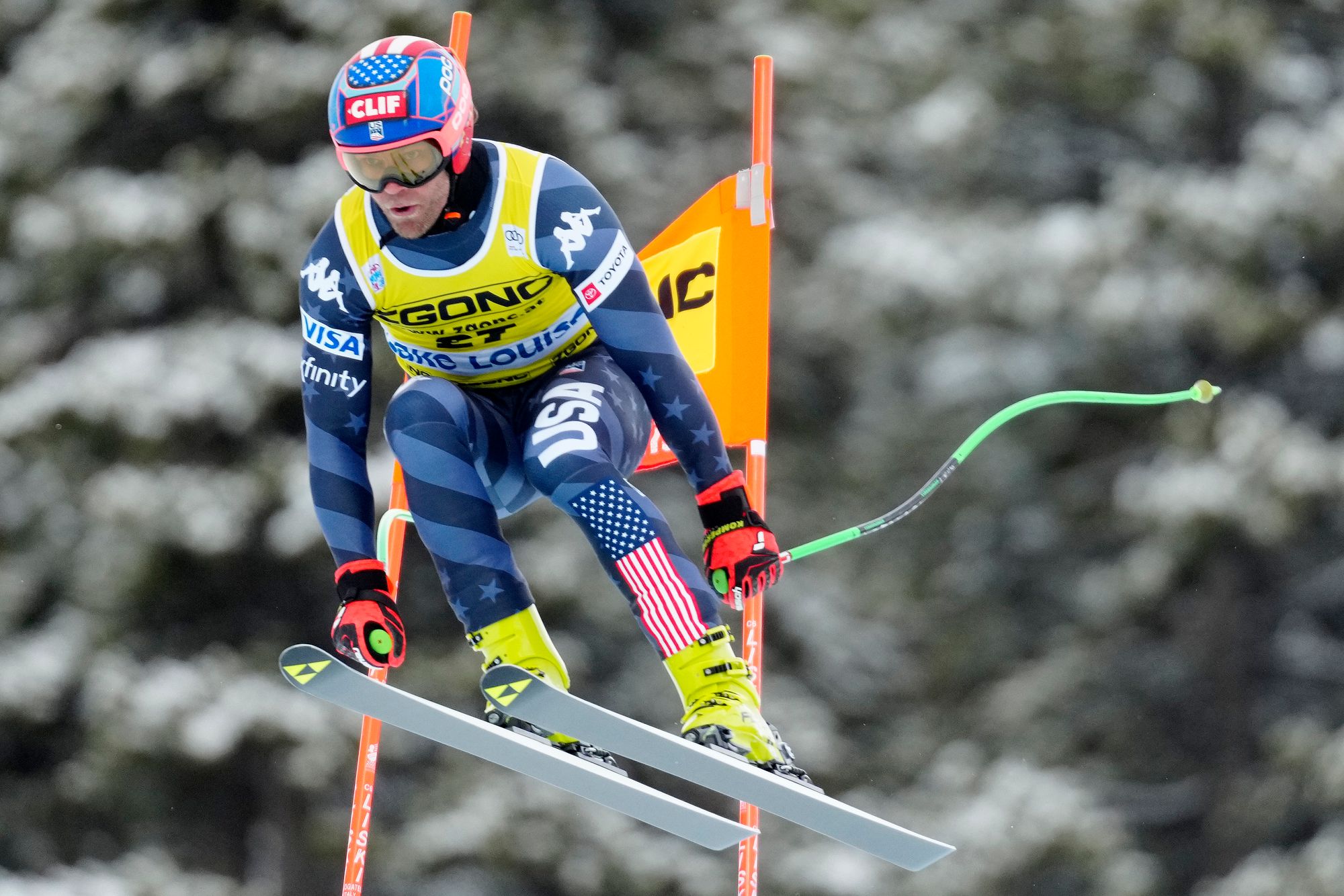
But … Knock knock. It’s the devil. Again.
Two devastating knee injuries - both knees, 364 days apart.
After overcoming the first, he battled his way back to qualify for the 2018 U.S. Olympic Team. Shortly before the Games were set to begin, he suffered the second injury. Both happened on the same course: Garmisch-Partenkirchen.
No Worlds. No Olympics.
At 36, most of his contemporaries were retiring. But Steven knew he wasn’t done. He continued that cycle of competing, getting injured, rehabbing, returning, competing — it was a grind.
In the end, at age 40, he was gunning for Beijing 2022. But a number of factors interfered, including spots going to countries in tropical locations and Covid-19 concerns.
Over nearly a 20-year career — largely unheard of in the sport of ski racing — he made four Olympic teams, earned 10 starts in World Championships, raced in 213 World Cups, finishing with 11 podiums and three wins, all at Val Gardena.
Asked what he admires most about Steven’s journey, his old coach Sasha Rearick offered plenty of memories. But it was Steven’s ability to bounce back after disappointment that always stuck with him.
“He never wavered in that belief and that spark. I look back on the two decades that I've been working with him and it's just like, ‘How many times have we been deep in that tank?’
“And he was just like, ‘We're doing it through the noise.’ That's remarkable. So much of what he did was by just always believing in himself,” Sasha says.
Full-fledged Girl Dad
There’s a park at the bottom of the canyon where Steven and his partner, former pro skier Charlotte Moats, live. On this beautiful spring day in May, he is playing in the sand volleyball courts with his daughters, Nell, 5, and Ayla, 2.
Eighteen years after first meeting him, it’s rewarding watching him in this moment. He is a full-fledged, name-tag-wearing Girl Dad. His girls adore him. He is the jungle gym, the family dog, the merry-go-round — he is the man who makes them laugh so hard, scream so loud and beg for more. With their infectious laughter echoed by his own, retirement seems more like the party is just getting started.
Steven and Charlotte were set up by friend and former U.S. Ski Team athlete Kaylin Richardson. Charlotte had already retired and was working her way through Dartmouth and the Wharton School of Business at the University of Pennsylvania. She was in Utah on a ski trip with Wharton, and Steven was injured with time on his hands. They met and soon began a romance that would be on-again, off-again until it was fully on-again, and they started a family.
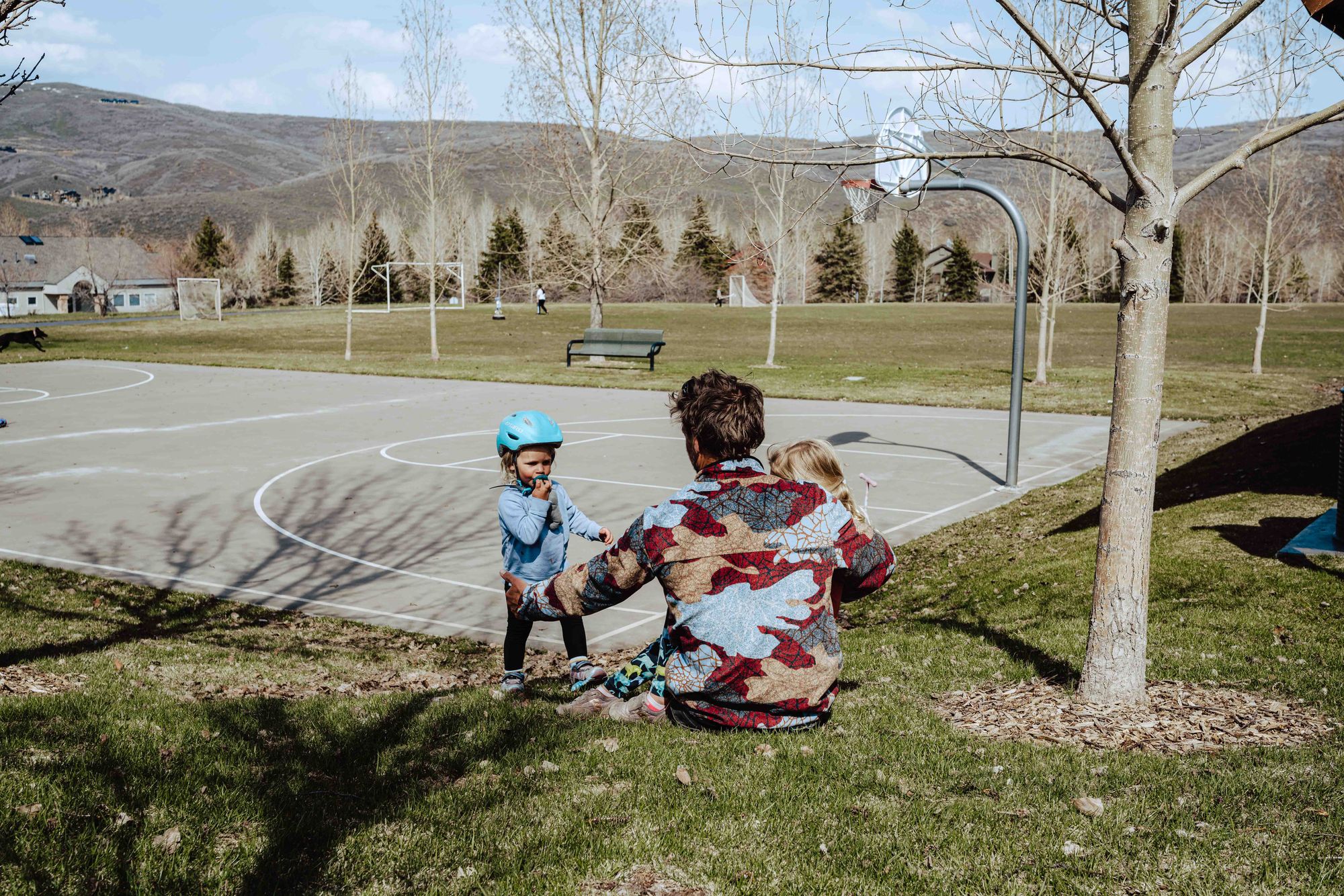
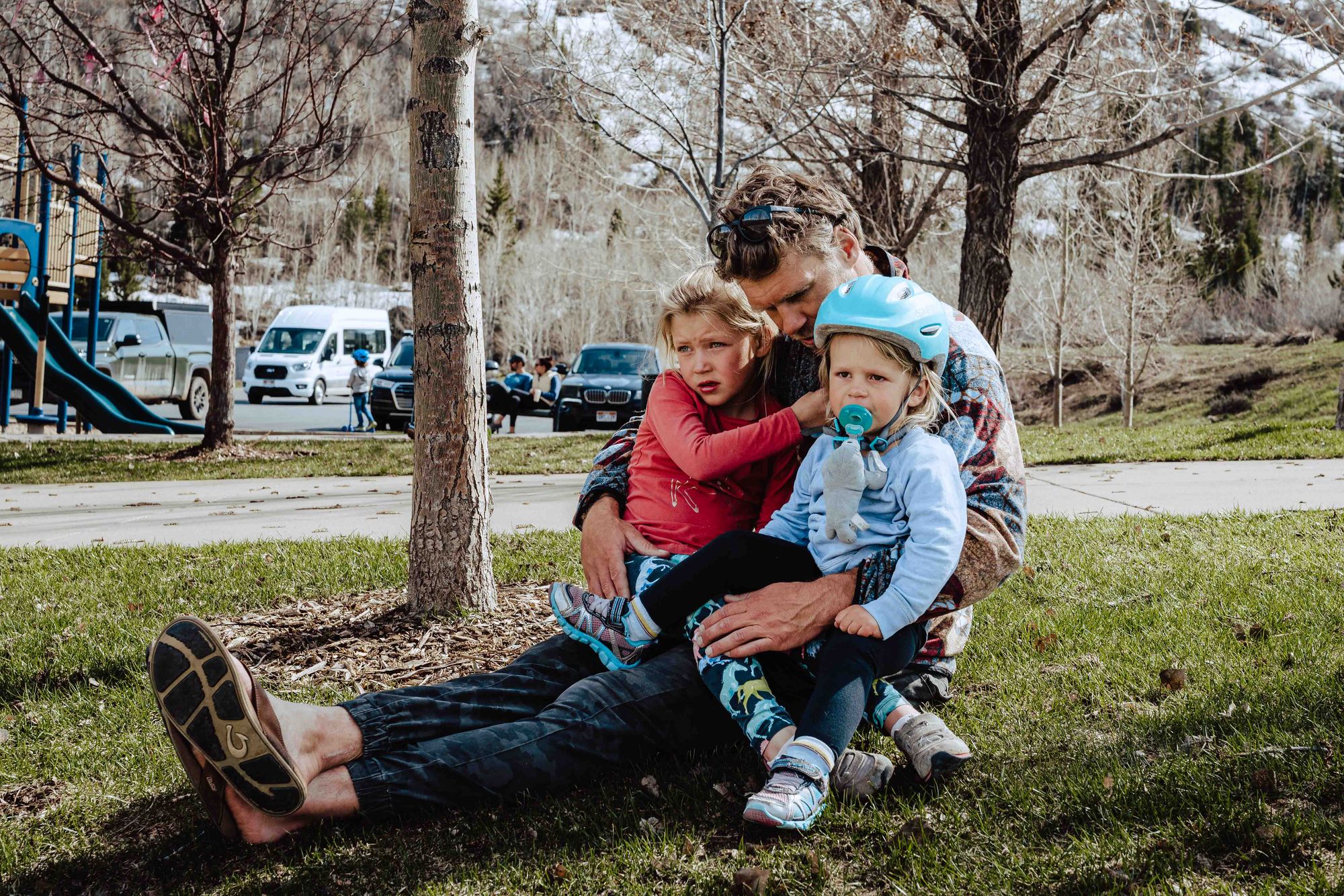
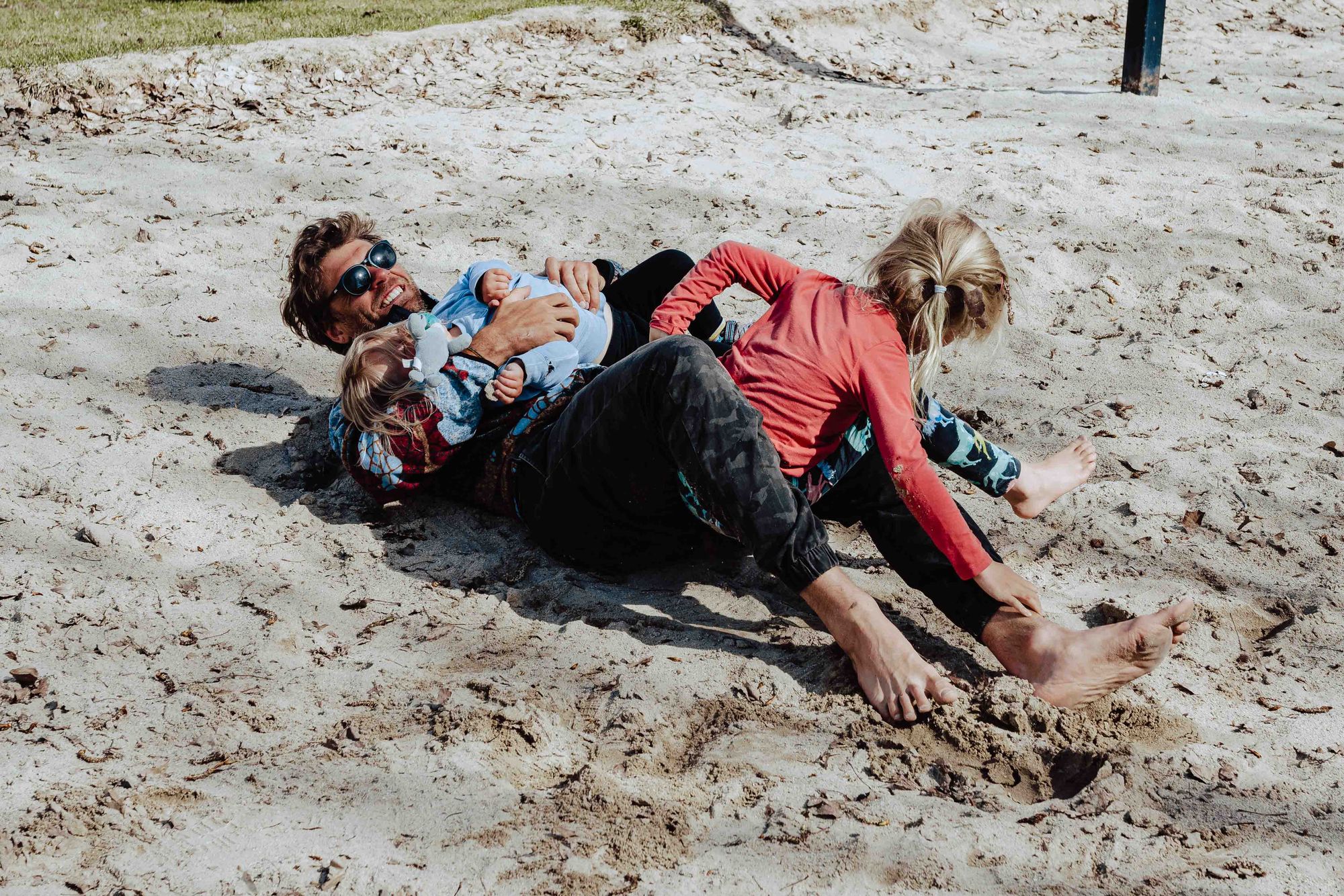
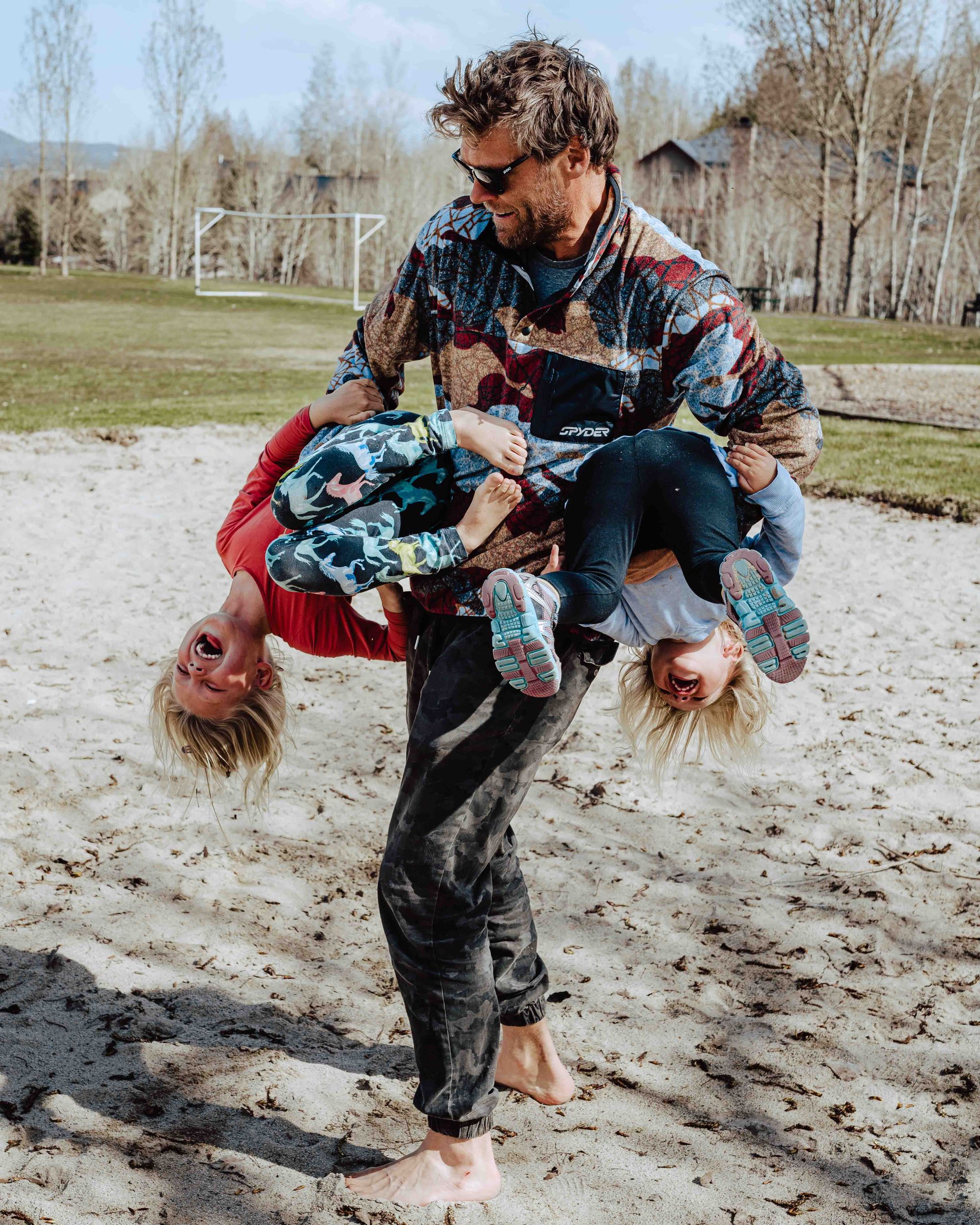
Steven with his girls, Nell and Ayla, near their home in Park City, Utah. [Matthew Fults photos]
When I asked Charlotte how she would describe Steven to people who didn’t know him, she laughs and says, “He’s the world’s biggest 12-year-old.”
“He is just passionate about everything that he does and is still fun-loving with everything that he does. Everybody falls in love with Steven. Whether it's guys who want to be more like him or grandmothers who just adore him or little girls or women of all ages who have crushes on him,” Charlotte says.
“He's just a very lovable guy. He's incredibly authentic.”
Charlotte was with him for most of the second half of his career, sharing in the highs and lows, the scary nights in hospital rooms, and the opening of the gender reveal email under starry skies on a remote mountain pass in Europe. All of it bleeds together and is absorbed by the woven fabric that has become his story.
She saw the anguish, the self-doubt, and the confidence of a man who loved his sport so much. She saw him become a leader, a mentor and a father. Since she was a pro skier, she could help him deconstruct runs, learn from failures, celebrate successes and dissect the peaks and valleys.
“He's visionary. He’s a dreamer. He’s an entrepreneur, and he's an intellectual,” Charlotte says, pausing to ponder her words. “He’s definitely an intellectual. I mean, that first night I met him, I think we sat and just talked about everything in the world for like four hours straight and I was like, ‘Wow, I guess there's a lot there with this guy.’”
Steven is known for being at the forefront of critical issues, such as climate change and science that helped extend his career (think wind tunnels and gyroscopes). He took recovery and rehab efforts to new levels, finding the latest innovations that would get him back to peak form sooner.
Tim Foley, a Bostonian who met Steven in 2007 and became fast friends, has been a loyal sidekick for years. He, too, has seen the evolution of Steven Nyman.
“I think ski racing is a hard life. Travel. Training. Injuries. Just the overall schedule, then you throw in a child into that and how he handled that. I think Steven has always tried to push the limit of what he can do because he always felt like he owed his best to the sport of ski racing.”
For the first time in his adult life, the White Circus isn’t calling. He doesn’t have a schedule. He skis for pleasure. He’s gone on vacations with his family. He has projects at home.
As a professional ski racer, he had several seasons where his earnings were mid-six figures. He’s done well. He and Charlotte bought a beautiful home in the mountains near Park City a few years back. The girls have plenty of space to play.
We are walking through historic downtown Park City amidst the brick-and-mortar walls of old mining saloons turned into upscale retail shops and restaurants. Near the legendary Egyptian Theatre — the centerpiece of the annual Sundance Film Festival — I ask him if he has any regrets.
At first he demurred. But upon reflection, he conceded this:
“I'd say the biggest regret would be not communicating my needs. Not stating what I wanted and really demanding it. I kind of took what I had and would make the best of it.
“And I wish I would have really put my foot down in certain situations and said, ‘No, we need to change this. Let's work on it. Let's go.’ Instead, I just kind of went with what was given to me. But that's kind of a theme of my career and life.”
Retired from racing, his future is wide open. He’s weighing several opportunities, from business deals to coaching. It’s only a matter of time before Steven Nyman is runnin’ down his next dream.
Check out Steven Nyman's segment in our 2023 television show.